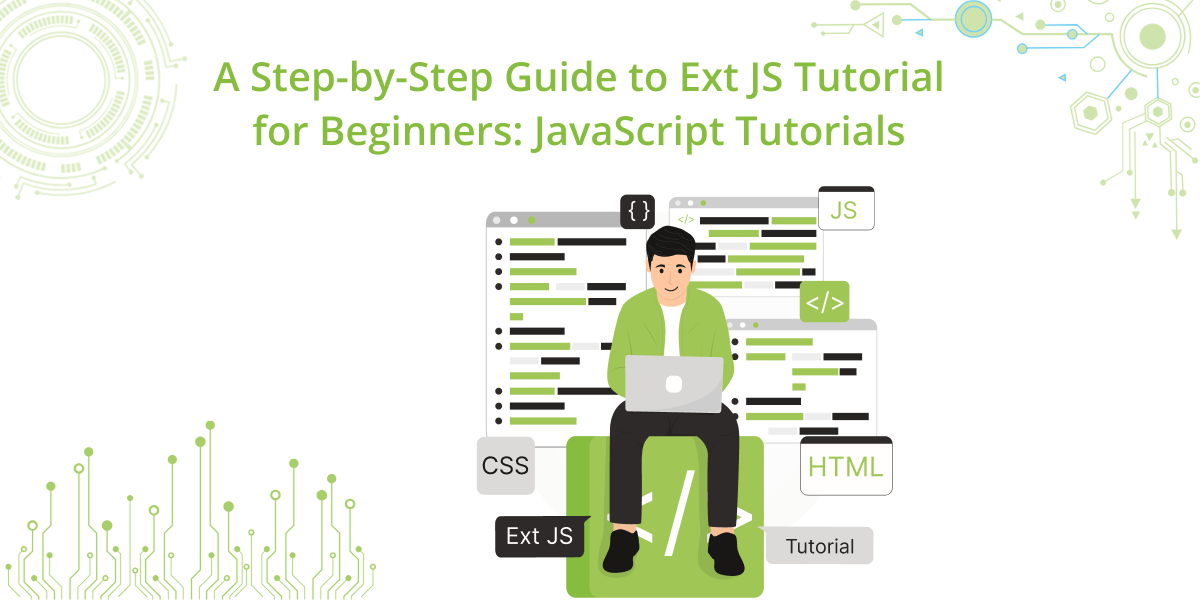A Step-by-Step Guide to Ext JS Tutorial for Beginners: JavaScript Tutorials
When you’re working on complex web or mobile apps, Ext JS is an appealing offer. Especially when dealing with tons of data. It’s a solid JavaScript framework that gives you a ready-made set of UI components like tables, forms, charts, and more. All are designed to work together without much setup.
Ext JS isn’t as lightweight or trendy as some other options, but that’s kind of the point. It’s built for apps where structure really matters. Think big dashboards or enterprise tools with lots of moving parts.

If you’re new to JavaScript and going through something like a JavaScript tutorial for beginners, chances are you’ve already bumped into React or Vue. But Ext JS takes a different route. It’s less about flexibility and more about giving you a full set of tools that just work together.
It’s especially useful if you prefer a full framework that covers layout, theming, event handling, and accessibility out of the box. Think of it as more of a complete solution than something like a JavaScript library vs framework debate might suggest.
In this blog, we will discuss a complete step-by-step guide to the Ext JS tutorial for beginners.
How to Download and Set Up Ext JS?
Starting with Ext JS is super simple, whether you’re just trying it out or already have a paid plan. If you’re new to coding and looking for a beginner-friendly JavaScript tutorial, this is a great way to get your hands dirty and build something real. You can simply do it by referring to our documentation.
Trial users can install the 30-day Ext JS package from the public npm like this:
npm install -g @sencha/ext-gen
If you’re an active customer, you’ll first need to log in to Sencha’s private npm registry, where all commercial packages live. Use the credentials from your support portal, and replace the @ in your email with .. (e.g., name.. gmail.com). Then run:
npm login --registry=https://npm.sencha.com/ --scope=@senchaAfter logging in, install Ext JS:
npm install -g @sencha/ext-genTo create your project, run:
ext-gen app -a -t moderndesktop -n ModernApp
cd ./modern-appYour app opens in the browser with a simple home page and grid view—great for exploring JavaScript web application frameworks.
Ext JS is often featured in JavaScript frameworks comparison guides for its built-in tools and strong structure. If you’ve done an HTML CSS JavaScript tutorial or even a JavaScript React tutorial, you’ll find Ext JS easy to follow.
It’s a powerful option among front-end JavaScript frameworks, perfect for dashboards and enterprise apps. If you’re exploring the most popular JavaScript frameworks or curious about JavaScript UI frameworks and JavaScript test frameworks, Ext JS is worth a try.
Can I Use Ext JS Through a CDN?
One of the best things about building for the web today is how you can pull in libraries and frameworks straight from a CDN. It makes things load faster and just works better for users everywhere. Now, if you’re wondering whether you can use Ext JS this way without downloading anything, you definitely can. Here’s what to do:
<HTML>
<head>
<link rel="stylesheet" type="text/css" href="https://cdnjs.cloudflare.com/ajax/libs/extjs/6.0.0/classic/theme-crisp/resources/theme-crisp-all.css"/>
<script type="text/javascript" src="https://cdnjs.cloudflare.com/ajax/libs/extjs/6.0.0/ext-all.js"></script>
<script type="text/javascript" src="app.js"></script>
</head>
</HTML>
Say you’re doing a small project or just tinkering with Ext JS along with some regular HTML and CSS, this trick really helps. This method saves a lot of time. I’ve found it super useful. Especially when following a JavaScript tutorial for beginners or one of those quick JavaScript React tutorials online.
CDNs let you skip all that setup stuff. Super skilled for quick demos or if your team just wants to test something fast. No dealing with version mix-ups, everyone’s looking at the same thing right away.
Also, files from CDNs usually load faster and more reliably. That means fewer errors and better caching, which is always a win. You’ll notice this is pretty common in front end JavaScript frameworks, especially when you’re just prototyping or building something simple right in the browser.
Honestly, if you’re exploring the most popular JavaScript frameworks or digging into a JavaScript frameworks list to compare options, starting with a CDN-based setup just makes things easier.
What Browsers Are Supported to Run Ext JS Applications?
If you’re working with Sencha Ext JS, you don’t have to stress about browser issues. It supports almost all the major ones.
On desktops, it works with:
- Chrome (latest version)
- Firefox (latest version)
- Safari 6 or newer
- Microsoft Edge (latest)
- Opera
On mobile devices, it handles:
- Safari 6+ on iPhones or iPads
- Chrome (latest) on Android
This kind of broad browser support really matters, especially when you’re looking at different JavaScript frameworks. Ext JS is strong here. It smooths out rendering quirks for each browser, so you’re not stuck writing weird hacks or testing the same thing five different ways.
That’s a big deal if your app has a lot of users logging in from all kinds of devices and browsers. Some newer front end JavaScript frameworks drop support for older versions. But Ext JS still has your back.
This is super helpful for teams building apps for companies or institutions where people might still be using older systems. So, if you’re picking a tool from the endless JavaScript frameworks list, and cross-browser reliability is a priority. Ext JS makes a solid case.
If you’re new to all this and following a JavaScript tutorial, or just checking out different JavaScript web frameworks. It’s honestly a relief when your app just works. No weird bugs across browsers. It makes learning a lot less frustrating.
What Are the Naming Conventions Followed in Ext JS?
If you’ve spent any time coding in JavaScript, you’ve probably noticed how much easier things get when you stick to clear naming rules. Ext JS sticks to the usual JavaScript naming style.
It’s not a strict rulebook, but following these conventions can make your code way easier to read and maintain, especially in bigger projects.
Let me break it down real quick:
- Classes usually kick off with a capital letter, stuff like EmployeeRecord or ProductDetail.
- Methods start with a lowercase and use camelCase, like calculateSalary().
- Variables follow the same camelCase vibe like productName.
- Constants are all uppercase, like MAX_VALUE, just to make them stand out.
- Properties are Lowercase camelCase again, like firstName or productPrice.
These conventions aren’t just for looks. They’re used across many front end JavaScript frameworks and even in some JavaScript backend framework setups. They help linters and auto-complete tools work better and make collaboration smoother when you’re building something with others.
When you’re working with a team, having a shared naming style just makes life easier. No one wants to waste time guessing what a variable means or why a method is named a certain way. It also helps when you have to jump into someone else’s code—or they dive into yours.
It’s just easier when the code looks familiar. You don’t have to pause every few lines trying to figure out what someone meant.
Want to level up your skills? Look for the best JavaScript online tutorial or a complete HTML, CSS, and JavaScript tutorial. Getting the basics like naming right early on makes everything else smoother down the line.
What Is the Project Structure and How Does It Work?
Once you start messing around with Ext JS, stuff like MVC and MVVM just sort of comes up. They’re part of how things are built. They’re just ways to keep your project tidy.
MVC splits your app into three parts: data (model), the stuff users see (view), and the logic in between (controller). MVVM helps to create a ViewModel. It acts as a bridge between the user interface and the data.
So when there is any modification in data, the UI updates on its own. You don’t have to worry about it.
If you change a value somewhere, it shows up everywhere it’s needed. That’s why MVVM works really well with today’s front-end JavaScript frameworks. Ext JS also gives you a solid project structure with separate folders for views, models, and controllers. That makes it easier to work in teams or on bigger projects.
How to Build Our First Program?
Let’s start with a simple Hello World program. Here’s an example:
<!DOCTYPE html>
<html>
<head>
<link href="https://cdnjs.cloudflare.com/ajax/libs/extjs/6.0.0/classic/theme-classic/resources/theme-classic-all.css" rel="stylesheet" />
<script src="https://cdnjs.cloudflare.com/ajax/libs/extjs/6.0.0/ext-all.js"></script>
<script>
Ext.onReady(function() {
Ext.create('Ext.Panel', {
renderTo: 'helloWorldPanel',
height: 200,
width: 600,
title: 'Hello world',
html: 'First Ext JS Hello World Program'
});
});
</script>
</head>
<body>
<div id="helloWorldPanel"></div>
</body>
</html>Think of this example as the “hello world” of any good JavaScript tutorial for beginners. It’s a simple intro to reusable UI components. A core idea is whether you’re using front-end JavaScript frameworks or hooking into a JavaScript backend framework.
What makes it really useful is how it walks through Ext JS basics.The Ext.onReady() function waits for the DOM to fully load before doing anything. That helps avoid annoying errors from scripts running too early.
Then Ext.create() is used to make an Ext.Panel, which is like a flexible box that can hold HTML or other Ext JS parts. Getting the hang of this builds a strong base. From here, you’ll be ready to explore layouts, events, data binding, and even dashboards.
It’s a lot like what you’d see in a JavaScript React tutorial or a good HTML, CSS, JavaScript tutorial, great stepping stones into popular JavaScript frameworks today.
How to Create Classes?
If you’re a beginner to Ext JS, your priority is to get comfortable with creating your own classes. It sounds intricate, but it’s really just a way to keep your code neat and make life easier as your app gets more complex.
You’ll usually use something called Ext.define() to set one up. Here’s a quick look at how it works:
Ext.define():
Ext.define('employeeApp.view.EmployeeDeatilsGrid', {
extend: 'Ext.grid.GridPanel',
id: 'employeesDetailsGrid',
store: 'EmployeesDetailsGridStore',
renderTo: 'employeesDetailsRenderDiv',
layout: 'fit',
columns : [
{ text: 'Employee Name', dataIndex: 'employeeName' },
{ text: 'ID', dataIndex: 'employeeId' }
]
});Pretty simple, right? This is a common pattern in front-end JavaScript frameworks, especially in enterprise tools like Ext JS. It’s the kind of thing you’ll also come across in a solid JavaScript tutorial for beginners or even a good JavaScript React tutorial.
So, why even bother with classes like this? Because they help you keep things in order. When similar bits of code are grouped together, it’s just easier to work with. You’ll spend less time on debugging and more time on building your project.
This setup also supports inheritance and mixins, basically, ways to share common logic across different parts of your app. These are core ideas across the most popular JavaScript frameworks and show up a lot in JavaScript frameworks comparison guides.
Whether you’re working on a JavaScript dashboard framework, testing tools, or just learning via the best JavaScript online tutorial, mastering class creation helps future-proof your projects. Clean structure now saves you major headaches later and gives your app the flexibility to grow.
Creating Objects in Ext JS
You can create objects using either:
Traditional JS:
var employeeObject = new employee();
employeeObject.getEmployeeName();Ext.create():
Ext.create('Ext.Panel', {
renderTo: 'helloWorldPanel',
height: 100,
width: 100,
title: 'Hello world',
html: 'Hello World'
});This approach lets you tweak how your class behaves right when you create it. That kind of flexibility is a big reason features like this are loved in today’s popular JavaScript frameworks. It also plays a big role in overall JavaScript framework popularity.
Inheritance
Inheritance in Ext JS works using extend or mixins:
Ext.define('studentApp.view.EmployeeDeatilsGrid', {
extend: 'Ext.grid.GridPanel',
});Or using mixins:
mixins: {
commons: 'DepartmentApp.utils.DepartmentUtils'
},You’ll often hear folks bring up Ext JS in the whole JavaScript library vs framework conversation, and for good reason. It’s super flexible. One cool feature is the extend keyword.
It lets you build a new class that grabs stuff from a parent class. That means you can take existing code and build on top of it by changing what you need. Can add what’s missing and keep things neat.
In this way, you can follow the classic inheritance style. It helps in managing the code base without it becoming chaotic.
Now, mixins work a little differently. They’re great when you want to share bits of functionality between classes without making everything related. Just add in what and where you need it. No complicated inheritance trees, as it helps you share code without creating complex class relationships.
Using both extends for structure and mixins for flexibility, you get the best of both worlds. It’s a setup that makes building complex apps feel more manageable, especially when things start scaling up. That’s one reason Ext JS shows up in JavaScript frameworks lists and gets love in JavaScript frameworks comparison posts.
It’s a solid pick for big projects that need scalable, maintainable code. No wonder it ranks among the most popular JavaScript frameworks, especially for JavaScript web application frameworks and JavaScript UI frameworks used in enterprise apps.
What Is Sencha CMD?
If you’ve experience in building an app with Ext JS, you know there’s a lot going on in the background. That’s where Sencha CMD comes in. It takes care of the setup, compiles your code, bundles your files, and preps everything for deployment.
Basically, it saves you from doing the same repetitive stuff over and over, so you can focus on actually building. It keeps your workflow smooth and helps avoid silly mistakes.
It’s kind of like how JavaScript unit testing frameworks automate test runs—CMD automates things like minification and bundling to boost performance and cut down load times.
If you’re moving on from a JavaScript tutorial for beginners, CMD steps things up with real-world tools. Great for anyone exploring JavaScript web application frameworks.
What Is Sencha Themer?
Sencha Themer is a tool I wish I had earlier. It lets you style your Ext JS apps without diving into CSS or Sass. You just click around, change colors, fonts, spacing, whatever, and see updates instantly.
It’s a huge time-saver, especially if you’re working with dashboards or larger projects using front-end JavaScript frameworks. What I really like is how easy it is to keep your app’s look consistent. There is no digging through messy CSS files or fixing stuff someone else broke.
Suppose you’re just starting out, maybe following a JavaScript tutorial or experimenting with a JavaScript dashboard framework. This tool takes a lot of pressure off. You can focus on building, not debugging styles, all day.
What Are Sencha Examples?
If you’re checking out Sencha Ext JS, the best thing you can do is to start with their example projects. They are full working demos, not only snippets. You’ll have everything from simple input forms and data charts to more complex dashboards and admin panels.
It’s a reliable method to get a feel for how the framework works without starting from scratch. It’s like a hands-on JavaScript tutorial for beginners, especially if you’re exploring front end JavaScript frameworks.
These examples make it easier to grasp how components work together, like layouts, toolbars, trees, you name it. Whether you’re digging into a JavaScript React tutorial or comparing JavaScript web application frameworks, these demos help.
They’re great for understanding UI patterns, testing setups, and what makes a framework truly powerful.
Are You Ready to Experience the Power of Ext JS?
Thinking about trying Ext JS. It’s a solid choice, especially if you’re already messing around with HTML, CSS, and JavaScript. Sencha Ext JS comes with an extensive collection of examples to showcase its capabilities
You get a bunch of prebuilt UI stuff and tools that work for both web and mobile. It’s not just for pros either. If you’ve done a JavaScript tutorial for beginners, you’ll feel right at home.
Download Sencha Ext JS Free Trial or Community Edition Now.
FAQs
What is the most popular JS framework?
React is at the top of the most popular JS frameworks. It’s mainly because of its flexibility. It has a huge community that helps you whenever you get stuck.
How is React different from other JS frameworks?
React focuses just on building user interfaces with reusable pieces and runs fast thanks to the virtual DOM.
What are web development frameworks?
Web development frameworks provide pre-built tools and structure instead of building from scratch. They speed up things and make tasks easier.
What are the core components of an Ext JS application?
Think of things like panels, buttons, grids, and forms. Basically, the building blocks you drag around to make the UI work.
What makes Ext JS different from React or Angular?
Ext JS gives you a full set of built-in features, while React and Angular often need add-ons to do the same stuff.
Which is easier to learn first: JavaScript or React?
Definitely start with JavaScript, it’s the foundation, and React won’t make much sense without it.
Can I use Ext JS with HTML, CSS, and JavaScript together?
Absolutely, it works perfectly with the standard web stack.
Is Ext JS suitable for beginners learning front-end JavaScript?
Yes, if you’ve done a basic JavaScript tutorial, you can pick it up with some effort.

Building software for regulated industries demands more than functional code. Healthcare organizations must protect patient…

The Ext JS Data Grid is widely regarded as one of the most feature‑rich and…

The integration of LLMs into Web application development has moved well beyond simple content generation…









